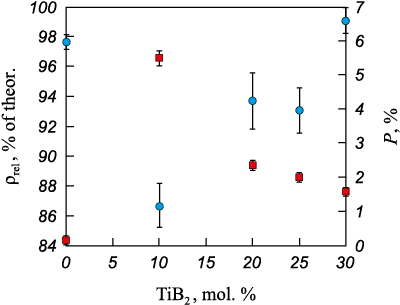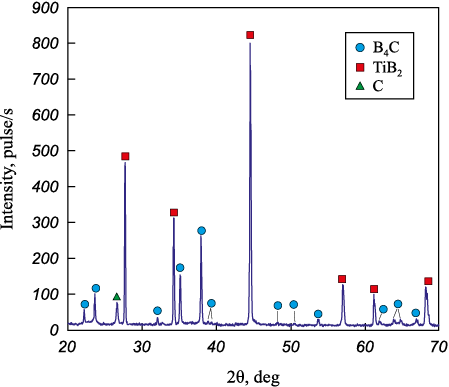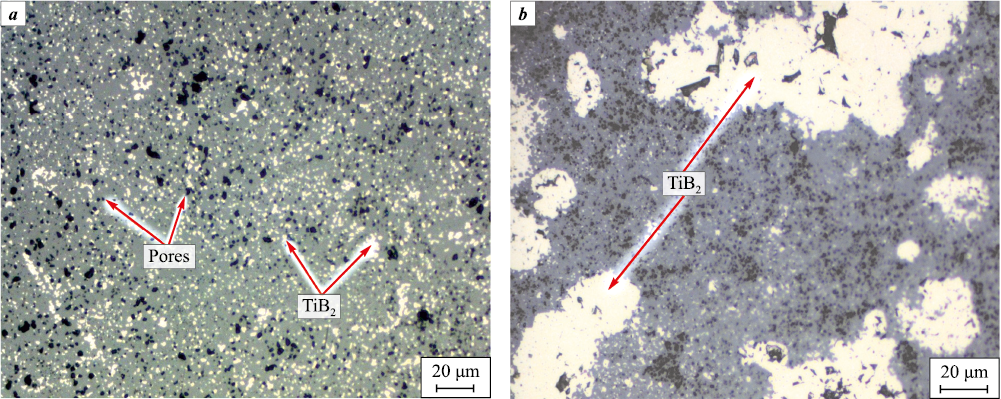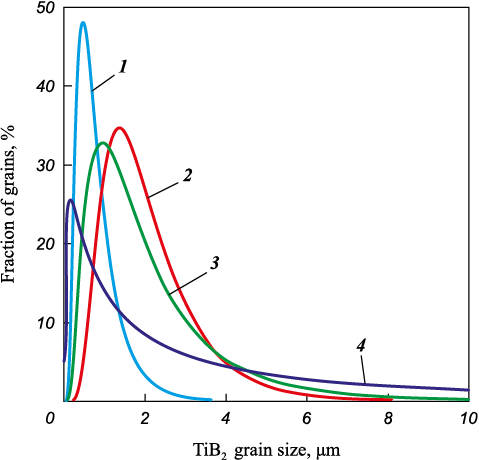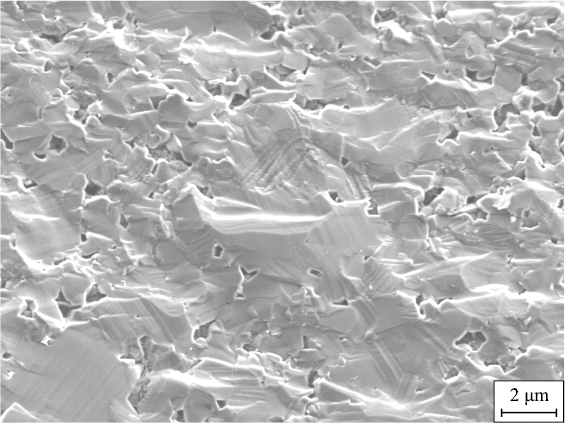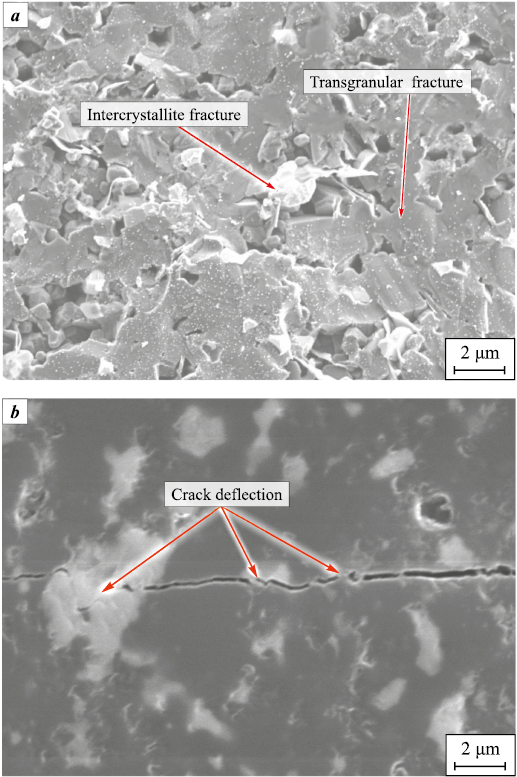Scroll to:
Phase composition, structure and properties of B4C–TiB2 ceramics produced by hot pressing
https://doi.org/10.17073/1997-308X-2024-2-23-34
Abstract
Composite ceramic materials based on B4C with the addition of TiB2 in amounts of 0, 10, 20, 25 and 30 mol. % have been studied. Titanium diboride was synthesized from TiO2 powder and nanofibrous carbon using the boron carbide method in an induction furnace at 1650 °C in an argon atmosphere. The samples were produced by hot pressing at 2100 °C and 25 MPa in an argon environment. The phase composition was determined, and the apparent density and open porosity of the experimental materials were measured. The microstructure was assessed using optical and scanning electron microscopy. The investigations revealed that an increase in the TiB2 content reduces the open porosity while concurrently enhancing the relative density of the boron carbide ceramics. For a sample containing 30 mol. % TiB2 , the open porosity and relative theoretical density were 1.6 and 99 %, respectively. Using XRD and XRS analyses established that the synthesized materials are comprised of two phases: B4C and TiB2 . The average grain size of TiB2 was 0.85 ± 0.02 µm for the sample with 10 mol. % TiB2 and 8.90 ± 0.25 µm for the material with 30 mol. % TiB2 . It was found that at higher TiB2 concentrations, large clusters of grains are formed. The destruction pattern of B4C grains is intragranular, while TiB2 grains are characterized by intergranular destruction. For a sample containing 30 mol. % TiB2 , the fracture toughness was 4.97 ± 0.23 MPa∙m0.5, and the hardness was 3320 ± 120 HV0.5 . Therefore, the addition of TiB2 at these specified concentrations facilitated a 30 % enhancement in fracture toughness relative to single-phase B4C while preserving a high level of hardness.
For citations:
Khabirov R.R., Cherkasova N.Yu., Gudyma T.S., Krutskii Yu.L., Mass A.V., Ogneva T.S., Kuzmin R.I., Anisimov A.G. Phase composition, structure and properties of B4C–TiB2 ceramics produced by hot pressing. Powder Metallurgy аnd Functional Coatings (Izvestiya Vuzov. Poroshkovaya Metallurgiya i Funktsional'nye Pokrytiya). 2024;18(2):23-34. https://doi.org/10.17073/1997-308X-2024-2-23-34
Introduction
Ceramics based on B4C are garnering significant interest from the research community due to their distinct combination of properties, including a high level of hardness (50 GPa) and low density (2.52 g/cm3), positioning them as a promising candidate for the fabrication of sandblasting nozzles [1–3].
Achieving a density in B4C ceramics that approximates the theoretical maximum is challenging due to the presence of strong covalent B–C bonds, a low self-diffusion coefficient, and substantial resistance to grain boundary slippage. B4C also presents limitations in terms of its relatively modest fracture toughness (3.1–3.2 MPa∙m\(^\rm{0.5}\)) [4] and bending strength (475–579 MPa) (475–579 МPa) [5].
Suppressing the growth of B4C grains through the establishment of a two-phase structure has been shown to enhance sintering conditions, thereby facilitating the production of ceramics with a relative density nearing the theoretical ideal [6; 7]. Furthermore, the development of composite materials derived from boron carbide impacts the pattern of destruction. Introducing dispersed particles that exhibit greater plasticity into the B4C matrix promotes the dissipation of crack energy within the ceramics [8], culminating in an increase in material fracture toughness [9].
Titanium diboride is frequently utilized as an additive that favorably influences the characteristics of B4C ceramics. The B4C–TiB2 system is characterized by an absence of significant mutual solubility, with TiB2 establishing a mechanical mixture alongside B4C. A composition comprising 75–78 mol. % B4C and 22–25 mol. % TiB2 aligns with a eutectic point that has a melting temperature of 2200 °C [10; 11]. Consequently, the sintering process for the B4C–TiB2 composite material is executed at a reduced temperature, resulting in a structure that features isolated TiB2 grains dispersed throughout a polycrystalline B4C matrix [12]. The coefficients of linear thermal expansion for titanium boride and boron carbide are markedly different (5.5∙10\(^–\)6 °С\(^–\)1 for TiB2 , 7.8∙10\(^–\)6 °С\(^–\)1 for TiB2) [13]. In this regard, in such materials, upon cooling after sintering, residual stresses arise, which, according to the authors of [14], reach 1 GPa. Therefore, upon cooling after sintering, residual stresses emerge within the material, which, as suggested by [14], can reach up to 1 GPa. Here, not only the magnitude but also the distribution of these stresses is of critical importance. Tensile stresses and microcracks tend to form along the grain boundaries, whereas the compressive stresses within B4C crystallites act to inhibit their growth and the subsequent development of macrocracks [15]. This stress distribution significantly contributes to the elevated fracture toughness observed in these ceramics [16; 17].
B4C–TiB2 composites produced via hot pressing (HP) attain a relative density of 99.8 % and a fracture toughness of 9.4 MPa∙m\(^\rm{0.5}\), albeit with a slight reduction in hardness (26 GPa) when contrasted with additive-free B4C [5; 14; 18–21]. It has been observed that the in-situ formation of titanium diboride within the material – arising from the synthesis of B4C, TiB2 , and carbon during ceramic sintering – contributes to enhanced mechanical properties of the sintered composite relative to composites incorporating directly added TiB2 powders [5; 14; 22]. Nevertheless, the mechanisms governing the evolution of the microstructure of B4C ceramics with varying concentrations of TiB2 additive, as well as its impact on the properties of the composites, remain insufficiently elucidated in the literature.
In the studies reported in [6], the properties and microstructure of B4C ceramics were analyzed in correlation with the concentration of the TiB2 additive. An increase in fracture toughness was observed with an increase in TiB2 content beyond 10 %; however, the incorporation of more than 30 mol. % TiB2 resulted in diminished hardness and bending strength, attributable to the intrinsically lower strength attributes of TiB2 . Additionally, an elevated TiB2 content exceeding 30 mol. % was correlated with a decrease in the composite’s relative density [12; 23], potentially due to TiB2 limited sinterability [6].
In the current research, TiB2 was synthesized through the boron carbide method using B4C, TiO2 , and a carbonaceous agent. Typically, acetylene black with a specific surface area (Ssp ) of approximately 50 m2/g is utilized as a carbon source in the synthesis of refractory oxygen-free compounds. In this instance, nanofibrous carbon, also with an Ssp of around 50 m2/g, was employed. The use of carbon materials with an expansive specific surface area is known to expedite solid-phase reactions, hence their application represents a promising avenue in the exploration of methodologies for synthesizing composite ceramics [24].
The objective of this study is to delineate the patterns in the formation of phase composition, microstructure, and properties of B4C composite ceramics that incorporate TiB2 synthesized with the aid of nanofibrous carbon.
Materials and methods
Highly dispersed B4C powders (98.5 % purity, 2.1 µm particle size), synthesized according to the method given in [25], TiO2 (99 %, purity, 1 µm particle size) and nanofibrous carbon (99 % purity) were utilized as the initial components. The latter consisted of granules 0.4–8.0 mm in size, which were composed of intertwined fibers with an average diameter of 73 nm, and was produced by the catalytic decomposition of natural and hydrocarbon gases [26]. To enhance reactivity, the nanofibrous carbon granules were pre-milled in an AGO-2S planetary mill for 5 min at an acceleration of 15g and a ball-to-material weight ratio of 15:1. The drums and milling media were made of ZrO2 . The average particle size of the nanofibrous carbon granules post-milling was 3.9 μm. The proportions of the initial powders in the mixture were calculated to facilitate the formation of 10, 20, 25 and 30 mol. % TiB2 in the sintered ceramics. Samples of B4C without additives were also prepared.
The composition of the powder mixtures was determined based on an analysis published data. Titanium diboride was synthesized in a solid phase reaction using the boron carbide method [27], according to the following reaction [22]
(1 – 0.5x)B4C + xTiO2 + 1.5xC = (1 – x)B4C + xTiB2 + 2xCO,
where x is the mole fraction of TiB2 in the mixture.
The mixing of boron carbide, titanium oxide, and nanofibrous carbon powders occurred in an AGO-2S planetary mill for 5 min at an acceleration of 20g, using a ball-to-material weight ratio of 30:1. Only powders that had been sieved through a 100 µm mesh were used. The synthesis of TiB2 was performed in an indirect heating induction furnace under an argon atmosphere at 1650 °C, with a dwell time of 20 min. The median particle sizes (d50) for the synthesized powders containing 10, 20, 25 and 30 mol. % TiB2 were 7.4, 8.3, 8.4 and 13.4 µm, respectively.
The synthesized powders were employed to fabricate samples by hot pressing (HP) at 2100 °C under a pressure of 25 MPa in an argon atmosphere. The HP process lasted for 70 min, with a dwell time at the maximum temperature of 25 min. The dimensions of the sintered samples were 20 mm in diameter and 4 mm in height. The HP parameters were chosen with consideration of published findings. For instance, research detailed in [28] indicates that a HP temperature of 2100 °C yields the highest relative density in ceramics. Other studies [29; 30] have also conducted hot pressing of B4C ceramics at this temperature.
Diffraction patterns were captured using an ARL X’TRA diffractometer (Thermo Scientific, Switzerland) equipped with a θ–θ goniometer. The end surfaces of the samples which had been cleared of any residues from the graphite paper used as a separator during the hot pressing process, were photographed after a meticulous grinding process.
The phase composition was determined utilizing the corundum number method. A profile analysis of the diffraction pattern was carried out in the Fityk software package (Poland) to assess the integral intensity of the largest phase peaks. The weight fraction of the phases was calculated according to the formula
\[{w_k} = \frac{{\frac{{I_k^{\max }}}{{RI{R_k}}}}}{{\sum {\frac{{I_i^{\max }}}{{RIR{}_k}}} }},\]
where \(I_k^{\max }\) is the integral intensity of the largest peak of the given phase, RIRk is the corundum number of that phase.
The apparent density and open porosity of the ceramics were measured by hydrostatic weighing. The relative density was determined as the ratio of the apparent density to the theoretical value:
\[{\rho _{{\rm{rel}}}} = \frac{{{\rho _{{\rm{app}}}}}}{{{\rho _{{\rm{theor}}}}}} \cdot 100{\rm{ }}\% .\]
The theoretical density for each composite was calculated using the rule of mixtures, referencing the X-ray density values of the components found in the literature B4C (2.5 g/cm3) and TiB2 (4.5 g/cm3) [31–33].
The average particle size of the powder was determined using a MicroSizer 201 VA Instrument laser particle size analyzer (VA Instalt, Russia). Microstructural examination was performed on polished sections and fracture surfaces employing EVO 50 optical and scanning electron microscopes (Carl Zeiss, Germany). To enhance the electrical conductivity of the samples under investigation, a copper layer approximately 20 nm in thickness was sputtered onto the polished surfaces. The chemical composition of the samples was analyzed through energy dispersive X-ray spectroscopy (EDX) using the INCA X-ACT system, and maps depicting the distribution of chemical elements were generated.
Hardness and fracture resistance measurements were conducted utilizing a 402MVD hardness tester (Wolpert Group, Germany) equipped with a diamond tetrahedral Vickers pyramidal indenter. Hardness was measured by the Vickers method under an indenter load of 500 g, while fracture toughness tests were administered with a load of 5 kg. The values of this index were initially computed using various methods, inclusive of equations from [34; 35]. The utilization of equations that consider Young’s modulus (E), especially when investigating composite materials with significant discrepancies in E values. Employing simplified equations often results in overestimations that deviate substantially from actual values [36]. Consequently, most literature concentrating on the evaluation techniques for calculating the critical stress intensity factor use equations that include Young’s modulus [34; 35]:
\[{K_{Ic}} = 0.048{\left( {\frac{l}{a}} \right)^{ - 0.5}}{\left( {\frac{{{H_v}}}{{E\varphi }}} \right)^{ - 0.4}}\frac{{{H_v}{a^{0.5}}}}{\varphi },\]
where Hv is the hardness, GPa; l is the crack length, μm; a is the indentation half diagonal, μm; φ = 3 is the constant.
The Young’s modulus of the experimental materials was determined using the rule of mixtures:
\[E = \frac{{100}}{{\frac{{{m_i}}}{{{E_i}}} + \frac{{{m_j}}}{{{E_j}}}}},\]
where Ei and Ej are the Young’s modulus values of B4C and TiB2 , respectively, GPa; mi and mj are their weight fractions, %.
For these calculations, the values of Young’s modulus for hot-pressed B4C (450 GPa) and TiB2 (530 GPa) were taken from [31–33].
Results and discussion
Open porosity and density
of composite ceramic materials
The study evaluated the impact of varying titanium diboride concentrations on the alteration of (ρrel ) and open porosity (P). The findings are illustrated in Fig. 1. In the B4C ceramics devoid of additives, a high ρrel was observed at 97.66 ± 0.49 %, with P = 0.07 ± 0.02 %. These figures confirm the appropriateness of the selected hot pressing parameters, which facilitated the production of low-porosity ceramics. Nevertheless, the sample containing 10 mol. % TiB2 exhibited a lower ρrel and increased P.
Fig. 1. Relative density ( |
With the escalation of TiB2 content to 30 mol. %, there was a 15 % increase in relative density and a 42 % reduction in open porosity in comparison to the specimen with 10 mol. % TiB2 . The resulting material’s relative density is on par with that of composite B4C ceramics reported in other studies [6; 7; 37].
Phase analysis
Fig. 2 presents the X-ray diffraction pattern of a composite material consisting of boron carbide and 30 mol. % titanium diboride, which is characterized by the highest relative density. The sample’s composition by weight percentage is: 65B4C, 31TiB2 and 4C.
Fig. 2. XRD pattern of B4C ceramic sample with 30 mol. % TiB2 |
Graphite paper served as a barrier between the punch and the powder during hot pressing. It is possible that particles of the graphite penetrated into the more profound pores evident on the sample’s surface. This could account for the carbon reflection observed in the diffraction pattern.
The lack of TiO2 reflections in Fig. 2 suggests the complete reaction of the starting powder materials. Furthermore, the absence of ZrO2 reflections implies that there was no significant attrition of the milling media during the milling process.
Microsrtructural study
The microstructure of composite ceramics with a 30 mol. % addition of TiB2 comprises a matrix (appearing gray in images) interspersed with light-colored clusters of varying sizes (Fig. 3, a). To elucidate the constituents of the structure, maps detailing the distribution of chemical elements were generated, and reflections indicative of boron and titanium were observed within these light clusters (Fig. 3, b). Consequently, these clusters have been identified as the TiB2 phase. The absence of zirconium in the spectral analysis further corroborates the lack of significant wear on the grinding media during processing.
Fig. 3. Results of EDX analysis of ceramics containing 30 mol. % TiB2 |
The material with 10 mol. % TiB2 exhibits a low relative density and elevated open porosity, which is attributed to the large number of pores (Fig. 4, a). TiB2 grains are evenly dispersed throughout the B4C matrix. However, an increase in TiB2 content is associated with the emergence of larger aggregates of this phase (Fig. 4, b).
Fig. 4. Microstructure of B4C samples with 10 mol. % (a) and 20 mol. % (b) TiB2 additions |
Fig. 5 provides histograms that portray the distribution of TiB2 grain size across composites of varying compositions, while an accompanying table lists their mean size (davg) along with the d50 and d90 statistics. The grain size distribution curves for the composite ceramics exhibit a unimodal configuration with a single pronounced peak. A lognormal function was employed to model the distribution curve of TiB2 grain sizes in the fabricated materials.
Fig. 5. Histogram plot of TiB2 grain size distribution in sintered ceramics:
Average size and parameters d50 , d90 of TiB2 grains
|
With an increment in TiB2 content within the material’s composition, there is a corresponding increase in the average size of the diboride grains, as well as the formation of large clusters. In the specimen containing 10 mol. % TiB2 , the largest grain clusters do not exceed 4.5 µm. The restricted range of size distribution in this ceramic suggests a uniform growth of the second phase inclusions. Conversely, clusters measuring up to 320 µm were identified in the sample with 30 mol. % TiB2 . The distribution function graph for the TiB2 grain sizes in this sample demonstrates an asymmetrical profile, with a considerable presence of coarse grains, as indicated by the elevated d90 values. Meanwhile, the d50 parameter shows only a minor increase with the rise in TiB2 concentration. Therefore, the microstructure of the ceramics is characterized by a combination of uniformly distributed fine TiB2 grains and larger grains and clusters. This phenomenon is likely due to the high degree of agglomeration present in the initial powder mixtures and the subsequent growth of these agglomerates during the TiB2 synthesis process.
Microstructural images from studies [18; 23] also affirm that the size of grain clusters for this phase expands as the TiB2 concentration increases. Findings by researchers in [38] demonstrate that employing finer B4C powder aids in creating fine-grained B4C–TiB2 ceramics with a more homogeneously distributed TiB2 phase.
To mitigate the inhomogeneity of the grain structure, it is advisable to extend the milling duration of the powder mixtures prior to the synthesis of TiB2 powder, and also to perform additional milling of the synthesized powder mixture.
Mechanical properties
The incorporation of TiB2, which possesses a lower hardness than B4C, results in a decrease in the hardness of the B4C–TiB2 composite as depicted in Fig. 6 and corroborated by numerous studies [7; 15]. The diminished fracture toughness observed in samples containing 10, 20, and 25 mol. % TiB2 additives is attributed to their high open porosity and low relative density. The presence of large pores within the ceramic matrix adversely affects its resistance to crack propagation [39]. Nevertheless, enhancing the TiB2 content to 30 mol. % yielded improvements in both hardness and fracture toughness over materials with lesser additive amounts and the pure B4C sample.
Fig. 6. Hardness ( |
Research in [6] reported the fabrication of ceramics with 30 mol. % TiB2 from commercial B4C and TiB2 powders through spark plasma sintering (P = 50 MPa, t = 2000 °C). The resultant material’s relative density was 97.91 % of theoretical, with a hardness of 28.86 ± 0.29 GPa and fracture resistance of 4.36 ± 0.1 MPa∙m\(^\rm{0.5}\)), figures that are inferior to those achieved in the current study. The authors of [6] suggest that the decreased performance metrics with TiB2 contents exceeding 5 mol. % are due to TiB2’s limited sinterability. In contrast, our study demonstrates an increase in the relative density of ceramics with rising TiB2 concentrations, underscoring the enhanced sinterability of titanium diboride synthesized via the boron carbide method compared to that of commercial powders.
The research presented in [38] involved synthesizing ceramics using commercial powders of B4C and 30 vol. % (37.5 mol. %) TiB2 by hot pressing at 2000 °C and 35 MPa. This process produced a material with a uniform distribution of TiB2 grains, a theoretical relative density of 100 %, and mechanical properties (Hv = 30.42 ± 0.79 GPa, KIc = 5.16 ± 0.19 MPa∙m\(^\rm{0.5}\) comparable to those observed in the present study, likely facilitated by intensive milling for 12 h.
Similarly, [12] describes ceramics with 30 vol. % (37.5 mol. %) TiB2 and 100 % relative density, prepared from commercial B4C and TiB2 powders subjected to 24 h of grinding and subsequently sintered by spark plasma sintering at 2000 °C and 60 MPa. This material exhibited a hardness of 31 ± 0.5 GPa and a fracture toughness of 3.75 ± 0.25 MPa∙m\(^\rm{0.5}\).
These comparative analyses indicate that the mechanical properties of the experimental material developed in this work are competitive with those of ceramics fabricated from commercial TiB2 powders. Hence, synthesizing TiB2 from relatively inexpensive starting materials such as TiO2 , carbon, and B4C emerges as a viable strategy to enhance the properties of B4C ceramics.
On the fracture surfaces of the initial B4C sintered sample (Fig. 7) and the sample containing 10 mol. % TiB2 (Fig. 8, a), transgranular fracture of B4C was observed. This indicates a significantly strong cohesive strength among the intergranular bonds. According to ceramic materials fracture theory, the dominance of a transgranular fracture mechanism positively influences fracture toughness.
Fig. 7. Fracture surface of sintered B4C without additives
Fig. 8. Microstructure of ceramics with addition of 10 mol. % TiB2 |
In certain TiB2 grains, a variation in the fracture pattern within the intergranular regions is noted (Fig. 8, b). Similar observations were made in previous studies [15; 22], especially when a crack transitions from B4C to TiB2 . Such variations could stem from alterations in the crack’s path as it approaches grains possessing a fracture toughness superior to that of the B4C matrix. This crack deflection process is likely to facilitate the dissipation of energy, thereby enhancing the mechanical properties of the composite ceramics [6]. In the examined material, such crack deflection was distinctly visible upon interaction with TiB2 grains (refer to Fig. 8, b), accounting for the observed increase in fracture toughness in the composite with 30 mol. % TiB2 in comparison to the additive-free B4C.
Conclusions
The investigation has established clear trends in the alterations to the microstructure and properties of B4C-based composite ceramics as a function of their composition.
1. X-ray phase analysis has verified that the sintered composite materials are composed of boron carbide and titanium diboride. The absence of TiO2 reflections in the X-ray diffraction patterns substantiates the complete synthesis of TiB2 .
2. An increment in the TiB2 content results in an enlarged average grain size of the diboride, with the formation of substantial clusters ranging between 100–320 μm. This phenomenon may contribute to increased anisotropy in the properties of the ceramics.
3. The prevalent fracture mechanism in B4C is observed to be transgranular, while TiB2 exhibits intergranular failure. This distinction underscores a modulation in the trajectory of cracks when encountering TiB2 particles, where crack deviation is associated with the dissipation of energy, thereby enhancing the composite’s fracture toughness.
4. The material incorporating 30 mol. % TiB2 exhibits a synergy of high fracture toughness and hardness. This composition is distinguished by its elevated relative density, diminished open porosity, and a robust cohesive strength among grains.
References
1. Jianxin D. Erosion wear of boron carbide ceramic nozzles by abrasive air-jets. Materials Science and Engineering A. 2005;408(1-2):227–233. https://doi.org/10.1016/j.msea.2005.07.029
2. Wang C., Lu Z., Zhang K. Microstructure, mechanical properties and sintering model of B4C nozzle with microholes by powder injection molding. Powder Technology. 2012;228:334–338. https://doi.org/10.1016/j.powtec.2012.05.049
3. Junlong S., Changxia L., Jin T., Baofu F. Erosion behavior of B4C based ceramic nozzles by abrasive air-jet. Ceramics International. 2012;38(8):6599–6605. https://doi.org/10.1016/j.ceramint.2012.05.045
4. Lee H., Speyer R. F. Hardness and Fracture Toughness of Pressureless-Sintered Boron Carbide (B4C). Journal of the American Ceramic Society. 2002;85(5):1291–1293. https://doi.org/10.1111/j.1151-2916.2002.tb00260.x
5. Yamada S., Hirao K., Yamauchi Y., Kanzaki S. High strength B4C–TiB2 composites fabricated by reaction hot-pressing. Journal of the European Ceramic Society. 2003;23(7):1123–1130. https://doi.org/10.1016/S0955-2219(02)00274-1
6. Liu Y., Li Z., Peng Y., Huang Y., Huang Z., Zhan D. Effect of sintering temperature and TiB2 content on the grain size of B4C–TiB2 composites. Materials Today Communications. 2020;23:100875. https://doi.org/10.1016/j.mtcomm.2019.100875
7. Guo W., Wang A., He Q., Tian T., Liu C., Hu L., Shi Y., Liu L., Wang W., Fu Z. Microstructure and mechanical properties of B4C–TiB2 ceramic composites prepared via a two-step method. Journal of the European Ceramic Society. 2021;41(14):6952–6961. https://doi.org/10.1016/j.jeurceramsoc.2021.07.013
8. Zhao S.M, Zhao L.R. Mechanical properties of hot-pressed B4C–TiB2 composites synthesized from B4C–TiO2 and B4C–TiC. Key Engineering Materials. 2021;902:81–86. https://doi.org/10.4028/www.scientific.net/KEM.902.81
9. Yuan Y., Ye T., Wu Y., Xu Y. Mechanical and ballistic properties of graphene platelets reinforced B4C ceramics: Effect of TiB2 addition. Materials Science and Engineering: A. 2021;817:141294. https://doi.org/10.1016/j.msea.2021.141294
10. Ordan’yan S.S., Nesmelov D.D., Danilovich D.P., Udalov Yu.P. SiC–B4C–MedB2 systems and the prospects for creating composite ceramic materials based on them. Powder Metallurgy and Functional Coatings. 2016;(4):41–50. (In Russ.). https://doi.org/10.17073/1997-308X-2016-4-41-50
11. Gunjishima I., Akashi T., Goto T. Characterization of directionally solidified B4C–TiB2 composites prepared by a floating zone method. Materials Transactions. 2002; 43(4):712–720. https://doi.org/10.2320/matertrans.43.712
12. Huang S.G., Vanmeensel K., Malek O.J.A., Van der Biest O., Vleugels J. Microstructure and mechanical properties of pulsed electric current sintered B4C–TiB2 composites. Materials Science and Engineering: A. 2011;528(3): 1302–1309. https://doi.org/10.1016/J.MSEA.2010.10.022
13. Carter C.B., Norton M.G. Ceramic materials. New York: Springer, 2013. 766 p.
14. Skorokhod V.V., Krstic V.D. Processing, microstructure, and mechanical properties of B4C–TiB2 particulate sintered composites. II. Fracture and mechanical properties. Powder Metallurgy and Metal Ceramics. 2000;39(9):504–513. https://doi.org/10.1023/A:1011378825628
15. Dai J., Pineda E.J., Bednarcyk B.A., Singh J., Yamamoto N. Macro-scale testing and micromechanics modeling of fracture behaviors for boron carbide composites with hierarchical microstructures. In: AIAA Scitech 2021 Forum (11–15 and 19–21 January 2021). USA, American Institute of Aeronautics and Astronautics, 2021. P. 14. https://doi.org/10.2514/6.2021-0405
16. Skorokhod V., Krstic V.D. High strength-high toughness B4C–TiB2 composites. Journal of Materials Science Letters. 2000;19(3):237–239. https://doi.org/10.1023/A:1006766910536
17. Ivanov Y.F., Khasanov O.L., Polisadova V.V., Petyukevich M.S., Milovanova T.V., Teresov A.D., Bikbaeva Z.G., Kalashnikov M.P., Bratukhina A.S. The analysis of the mechanisms for plasticization of boron carbide ceramics irradiated by an intense electron beam. Key Engineering Materials. 2016;685:700–704. https://doi.org/10.4028/www.scientific.net/KEM.685.700
18. Yue X.Y., Zhao S.M., Yu L., Ru H.Q. Microstructures and mechanical properties of B4C–TiB2 composite prepared by hot pressure sintering. Key Engineering Materials. 2010;34:50–53. https://doi.org/10.4028/www.scientific.net/KEM.434-435.50
19. Yue X.Y., Zhao S.M., Lü P., Chang Q., Ru H.Q. Synthesis and properties of hot pressed B4C–TiB2 ceramic composite. Materials Science and Engineering: A. 2010;527(27-28):7215–7219. https://doi.org/10.1016/J.MSEA.2010.07.101
20. Liu A.D., Qiao Y.J., Liu Y.Y. Pressureless sintering and properties of boron carbide-titanium diboride composites by in situ reaction. Key Engineering Materials. 2012;525:321–324. https://doi.org/10.4028/www.scientific.net/KEM.525-526.321
21. Li A., Zhen Y., Yin Q., Ma L., Yin Y. Microstructure and properties of (SiC, TiB2)/B4C composites by reaction hot pressing. Ceramics International. 2006;32(8):849–856. https://doi.org/10.1016/j.ceramint.2005.05.022
22. Skorokhod V.V., Krstic V.D. Processing, microstructure, and mechanical properties of B4C–TiB2 particulate sintered composites. Part I. Pressureless sintering and microstructure evolution. Powder Metallurgy and Metal Ceramics. 2000;39(7):414–423. https://doi.org/10.1023/A:1026625909365
23. Wang Y., Peng H., Ye F., Zhou Y. Effect of TiB2 content on microstructure and mechanical properties of in-situ fabricated TiB2/B4C composites. Transactions of Nonferrous Metals Society of China. 2011;21:369–373. https://doi.org/10.1016/S1003-6326(11)61608-7
24. Gudyma T.S., Krutskii Y.L., Maskimovskii E.A., Ukhina A.V., Aparnev A.I., Smirnov A.I., Uvarov N.F. Synthesis of B4C/ZrB2 composite powders via boron carbide reduction for ceramic fabrication. Inorganic Materials. 2022;58(9):912–921. https://doi.org/10.1134/S0020168522090059
25. Krutskii Y.L., Bannov A. G., Sokolov V.V., Dyukova K.D., Shinkarev V.V., Ukhina A.V., Maksimovskii E.A., Pichugin A.Yu., Solov’ev E.A., Krutskaya T.M., Kuvshinov G.G. Synthesis of highly dispersed boron carbide from nanofibrous carbon. Nanotechnologies in Russia. 2013;8(3): 191–198. https://doi.org/10.1134/S1995078013020109
26. Kurmashov P.B., Maksimenko V.V., Bannov A.G., Kuvshinov G.G. Horizontal vibrofluidized bed pilot reactor for nanofibrous carbon synthesis process. Khimicheskaya tehnologiya. 2013;14(10):635–640. (In Russ.).
27. Krutskii Y.L., Krutskaya T.M., Gudyma T.S., Gerasimov K.B., Khabirov R.R., Mass A.V. Carbothermal and boron carbide reduction of oxides of some transition metals. In: Proceedings of VII International Russian–Kazakhstan Conference «Chemical Technologies of Functional Materials» (Novosibirsk, Russia, 28–30 April 2021). MATEC Web of Conferences, 2021. P. 01040. https://doi.org/10.1051/matecconf/202134001040
28. Angers R., Beauvy M. Hot-pressing of boron carbide. Ceramics International. 1984;10(2):49–55. https://doi.org/10.1016/0272-8842(84)90025-7
29. Hwang C., DiPietro S., Xie K.Y., Yang Q., Celik A.M., Khan A.U., Domnich V., Walck S., Hemker K.J., Haber R.A. Small amount TiB2 addition into B4C through sputter deposition and hot pressing. Jouranl of the American Ceramic Society. 2019;102(8):4421–4426. https://doi.org/10.1111/jace.16457
30. He P., Dong S., Kan Y., Zhang X., Ding Y. Microstructure and mechanical properties of B4C–TiB2 composites prepared by reaction hot pressing using Ti3SiC2 as additive. Ceramics International. 2016;42(1A):650–656. https://doi.org/10.1016/j.ceramint.2015.08.160
31. Thevenot F. Boron carbide – A comprehensive review. Journal of the European Ceramic Society. 1990;6(4): 205–225. https://doi.org/10.1016/0955-2219(90)90048-K
32. Tee K.L., Lu L., Lai M.O. In situ processing of Al–TiB2 composite by the stir-casting technique. Journal of Materials Processing Technology. 1999;89-90:513–519. https://doi.org/10.1016/S0924-0136(99)00038-2
33. Yi H., Ma N., Zhang Y., Li X., Wang H. Effective elastic moduli of Al–Si composites reinforced in situ with TiB2 particles. Scripta Materialia. 2006;54(6):1093–1097. https://doi.org/10.1016/j.scriptamat.2005.11.070
34. Khasanov A.O. Development of compositions and technology of spark-plasma sintering of ceramic materials, composites based on micro- and nanopowders В4С: Diss. Cand Sci. (Eng.). Tomsk: TPU, 2015. (In Russ.).
35. Niihara K., Morena R., Hasselman D.P.H. Evaluation of KIc of brittle solids by the indentation method with low crack-to-indent ratios. Journal of Materials Science Letters. 1982;1(1):13–16. https://doi.org/10.1007/BF00724706
36. Khasanov O.L., Struts V.K., Sokolov V.M., Polisadova V.V., Dvilis E.S., Bikbaeva Z.G. Methods for measuring microhardness and crack resistance of nanostructured ceramics. Tomsk: Publishing House of Tomsk Polytechnic University, 2011. 101 p. (In Russ.).
37. Chen D., Zhang K., Zeng J., Guo H., Li B. High-strength TiB2–B4C composite ceramics sintered by spark plasma sintering. International Journal of Applied Ceramic Technology. 2022;19(4):1949–1955. https://doi.org/10.1111/ijac.14051
38. Liu Z., Deng X., Li J., Sun Y., Ran S. Effects of B4C particle size on the microstructures and mechanical properties of hot-pressed B4C–TiB2 composites. Ceramics International. 2018;44(17):21415–21420. https://doi.org/10.1016/j.ceramint.2018.08.200
39. Yaşar Z. A., Celik A.M., Haber R.A. Improving fracture toughness of B4C–SiC composites by TiB2 addition. International Journal of Refractory Metals and Hard Materials. 2022;108:105930. https://doi.org/10.1016/j.ijrmhm.2022.105930
About the Authors
R. R. KhabirovRussian Federation
Roman R. Khabirov – Postgraduate Student at the Department “Materials Science in Mechanical Engineering”
20 Karl Marx Prosp., Novosibirsk 630073, Russia
N. Yu. Cherkasova
Russian Federation
Nina Yu. Cherkasova – Cand. Sci. (Eng.), Junior Researcher of the Research Laboratory of Physical and Chemical Technologies and Functional Materials
20 Karl Marx Prosp., Novosibirsk 630073, Russia
T. S. Gudyma
Russian Federation
Tatiana S. Gudyma – Junior Researcher of the Laboratory of Chemical Technology of Functional Materials
20 Karl Marx Prosp., Novosibirsk 630073, Russia
Yu. L. Krutskii
Russian Federation
Yurii L. Krutskii – Dr. Sci. (Eng.), Associate Professor at the Department of Chemistry and Chemical Technology
20 Karl Marx Prosp., Novosibirsk 630073, Russia
A. V. Mass
Russian Federation
Anna V. Mass – Postgraduate Student at the Department “Materials Science in Mechanical Engineering”
20 Karl Marx Prosp., Novosibirsk 630073, Russia
T. S. Ogneva
Russian Federation
Tatiana S. Ogneva – Cand. Sci. (Eng.), Senior Researcher of the Research Laboratory of Physical and Chemical Technologies and Functional Materials
20 Karl Marx Prosp., Novosibirsk 630073, Russia
R. I. Kuzmin
Russian Federation
Ruslan I. Kuzmin – Cand. Sci. (Eng.), Junior Researcher at the Center for Technological Excellence
20 Karl Marx Prosp., Novosibirsk 630073, Russia
A. G. Anisimov
Russian Federation
Alexander G. Anisimov – Cand. Sci. (Phys.-Math.), Senior Researcher of the Laboratory “Synthesis of Composite Materials”
15 Academician Lavrentiev Prosp., Novosibirsk 630090, Russia
Review
For citations:
Khabirov R.R., Cherkasova N.Yu., Gudyma T.S., Krutskii Yu.L., Mass A.V., Ogneva T.S., Kuzmin R.I., Anisimov A.G. Phase composition, structure and properties of B4C–TiB2 ceramics produced by hot pressing. Powder Metallurgy аnd Functional Coatings (Izvestiya Vuzov. Poroshkovaya Metallurgiya i Funktsional'nye Pokrytiya). 2024;18(2):23-34. https://doi.org/10.17073/1997-308X-2024-2-23-34




